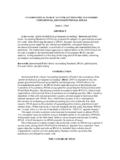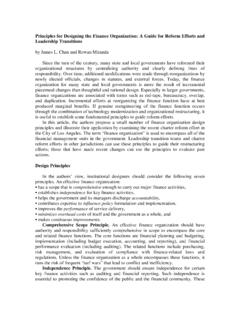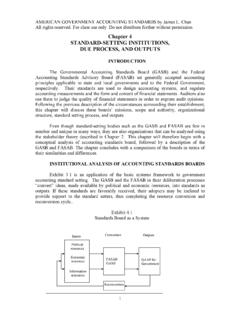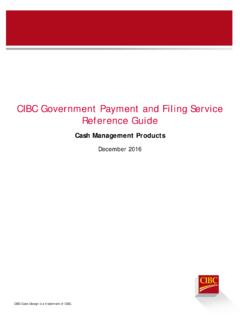Transcription of GOVERNMENT FINANCIAL REPORTING STANDARDS AND …
1 DRAFT CHAPTER FOR HANDBOOK ON PUBLIC FINANCIAL MANAGEMENT. DO NOT QUOTE OR CIRCULATE 35 GOVERNMENT FINANCIAL REPORTING STANDARDS AND practices James L. Chan and Yunxiao Xu GOVERNMENT FINANCIAL REPORTING makes public the data collected and accumulated in the GOVERNMENT accounting system discussed in the previous chapter. This chapter is primarily concerned with the FINANCIAL reports, particularly year-end FINANCIAL statements, produced with data in a GOVERNMENT s ex post FINANCIAL accounting system. It will also deal with the reports for monitoring budget execution, and statistical reports for national and international macro-fiscal comparisons, and compare these three REPORTING systems. It is intended to be useful both to general readers and to practitioners who are responsible for: (a) determining the structure and content of FINANCIAL reports; (b) approving the accounting policies used to prepare FINANCIAL statements; (c) explaining the FINANCIAL reports to legislators and the public; (d) dealing with auditors to resolve disputes; and (e) ensuring the proper use of information in FINANCIAL reports in the GOVERNMENT s decision-making processes.
2 After discussing some basic principles and concepts, the chapter will feature many examples of FINANCIAL REPORTING . These illustrations are grouped in terms of basic FINANCIAL statements for the whole of GOVERNMENT , disclosures in year-end FINANCIAL reports, budget-related REPORTING , REPORTING for components of a GOVERNMENT , and reports compiled from finance statistics. The chapter will conclude with a series of recommendations for improving FINANCIAL REPORTING STANDARDS and practices . 2 An Overview of GOVERNMENT FINANCIAL REPORTING This overview will present a set of basic principles of GOVERNMENT FINANCIAL REPORTING , discuss the trend in emphasizing FINANCIAL REPORTING in accounting STANDARDS , the concept of general purpose FINANCIAL statements, and the objectives of FINANCIAL REPORTING . Basic Principles Reflecting their political culture, governments around the world vary in their fiscal transparency.
3 While the GOVERNMENT FINANCIAL REPORTING practices in the Anglo-American tradition have become the benchmark against which national practices are measured, Western democracies share the following basic principles: 1. Credibility. GOVERNMENT FINANCIAL reports should be trustworthy by presenting objective and reliable information in accordance to STANDARDS set by a body with a high degree of independence. 2. Fair Presentation. Even though total disclosure is impossible and unnecessary, governments should accurately and adequately disclose their FINANCIAL conditions and performance. 3. Value Added. GOVERNMENT FINANCIAL reports should add value relative to the GOVERNMENT s already disclosed budgets and other fiscal information. Constrained by their historical orientation and unavoidable time lag, the special value of year-end FINANCIAL reports lies in providing a long-term and overall perspective. 4. Consistency and Uniformity.
4 The same measurement rules should be used over time unless circumstances change, and the same REPORTING formats should be used whenever possible, so as 3 to increase the understandability and comparability of FINANCIAL reports. Furthermore, FINANCIAL , budgetary and statistical REPORTING rules should be harmonized when possible, aligned when necessary, or otherwise reconciled. 5. Annual FINANCIAL Statements. At year-end governments should issue three basic FINANCIAL statements based on its accounts: a statement of FINANCIAL position in terms of assets, liabilities, net assets; a statement of FINANCIAL performance in terms of revenues and expenses, and gains and losses; and a statement of cash flows classified in terms of operating, investing and financing activities. These general purpose FINANCIAL statements (GPFS) provide common knowledge to all the stakeholders of the 6. FINANCIAL Disclosures. Due to the limitations imposed by accounting recognition criteria and measurement techniques (discussed in previous chapter), general purpose FINANCIAL statements should be complemented by additional FINANCIAL data to achieve the goals of accountability and transparency.
5 7. REPORTING Entity. General purpose FINANCIAL statements should cover the GOVERNMENT as a whole, including the primary GOVERNMENT (controlling entity) and the other controlled entities for which the primary GOVERNMENT is financially The fiscal relationships among these entities should be clarified, especially when the inter-relationships are not visible on the face of aggregative FINANCIAL statements. Additional reports should be prepared and made available for the components of a GOVERNMENT , such as departments and funds, to facilitate management and oversight. 4 8. Full REPORTING Capacity. A GOVERNMENT s FINANCIAL information system should be capable of generating data for assessing budget execution, interim and year-end FINANCIAL reports, as well as statistical reports and others required by laws and regulations. 9. Budgetary REPORTING . For any fiscal year, a GOVERNMENT should report, at the appropriate time and level of aggregation: initial and revised budgets and other FINANCIAL plans; results of budget execution, including revenue collection and spending; and explaining FINANCIAL results measured with different methods.
6 10. Statistical REPORTING . GOVERNMENT FINANCIAL data and reports should serve as the foundation of GOVERNMENT finance statistics compiled by national and international statistical offices, in order to facilitate international comparable evaluations of economic impacts and fiscal soundness of governments. From Accounting to REPORTING The above principles are embodied in REPORTING STANDARDS and practices discussed throughout this chapter. As the previous chapter explained, general purpose FINANCIAL statements of the REPORTING entity (identified in Principles 5 and 7 above) are the products of a systematic process of: Identification of transactions and events whose consequences would be analyzed in terms of their effects on the entity s economic resources and obligations; Recognition of some economic resources as assets and some obligations as liabilities, as well as subsequent changes on revenues and expenses, gains and losses; Measurement of the stock and flow measures mentioned above; and REPORTING of the resulting measurements of recognized items in the FINANCIAL 5 statements, and unrecognized items in FINANCIAL disclosures.
7 During the past four decades, accounting STANDARDS and policies have shifted from providing guidance on identification, recognition and measurement to the specification of the form and contents of FINANCIAL statements and In the private sector, International Accounting STANDARDS have become International FINANCIAL REPORTING STANDARDS (IFRS). Similarly, International Public Sector Accounting STANDARDS (IPSASs) are actually accounting and FINANCIAL REPORTING STANDARDS , and the same pattern has happened with the STANDARDS produced by the American Federal Accounting STANDARDS Advisory Board (FASAB) and Governmental Accounting STANDARDS Board (GASB); see Box 1). Box 1. Contents of FINANCIAL REPORTING STANDARDS General Principles [Details omitted] FINANCIAL REPORTING Defining the FINANCIAL REPORTING entity Comprehensive Annual FINANCIAL Report Additional FINANCIAL REPORTING considerations Notes to FINANCIAL statements Budgetary REPORTING Cash flows statements Segment information REPORTING entity and component unit presentation and disclosures Supplemental and special purpose REPORTING Statistical Section Interim FINANCIAL REPORTING Specific Balance Sheet and Operating Statement Items [over 30 topics; details omitted] Stand-alone REPORTING specialized units and activities [details omitted] Source: Adapted from annual (2011) Codification of Governmental and FINANCIAL REPORTING STANDARDS published by the GASB.
8 6 General Purpose FINANCIAL Statements In the English-language literature, unless otherwise specified, FINANCIAL REPORTING STANDARDS , generally refer to the rules to be observed in preparing general purpose FINANCIAL statements (GPFS). In the private sector, these FINANCIAL statements are intended for investors and creditors, in contrast to special purpose FINANCIAL reports, which are internal reports to management and external reports required by tax and regulatory authorities. The concept of GPFS was borrowed by state and local governments in the 1970s and by the federal GOVERNMENT in the 1990s in the United States to establish a separate domain for setting STANDARDS for external FINANCIAL REPORTING , to avoid infringing upon the prerogatives of legal authorities. This governance model has been elevated to the international level with the IPSAS Board (see previous chapter for details). The concept of GPFS is new to governments in many countries, particularly where the primary object of FINANCIAL REPORTING is the results of budget execution.
9 In these countries, during the fiscal year and at year-end, actual revenues and expenditures are reported, either alone or in comparison to projected revenues and appropriations, respectively. These comparisons are used during the year to improve performance or reset fiscal targets. At the end of a fiscal year, they could also be used to explain why the actual deficit was different from the annual budgeted deficit. (In contrast, since a company s budget is proprietary information, such actual to budget comparisons are not part of the business external FINANCIAL REPORTING model.) Therefore FINANCIAL REPORTING is not universally understood as only year-end REPORTING to the public. For example, China has pursued its own path to establishing a framework of accounting and FINANCIAL REPORTING (Box 2). Box 2. The Development of GOVERNMENT FINANCIAL REPORTING Practice in China 7 By Western STANDARDS , Chinese GOVERNMENT FINANCIAL REPORTING is less than satisfactory.
10 No GOVERNMENT units have issued consolidated FINANCIAL statements. There are no generally accepted accounting principles (GAAP) for governments. The Accounting STANDARDS Committee is part of the Ministry of Finance, and the sub- committee on GOVERNMENT and nonprofit organizations has been dormant. The supreme audit institution reports to the prime minister. Indeed, there is no GOVERNMENT accounting as such; officially it is budget accounting. Yet, considering that GOVERNMENT FINANCIAL data were still regarded as state secrets as recently as 30 years ago, China has come a long way. The Chinese minister of finance and his provincial and local counterparts annually present budget messages for the budget year and the final accounts for the past year to the people s congresses. Now, the GOVERNMENT is required to publish the national budget, covering the central GOVERNMENT and the local GOVERNMENT sector within 15 days of approval.








